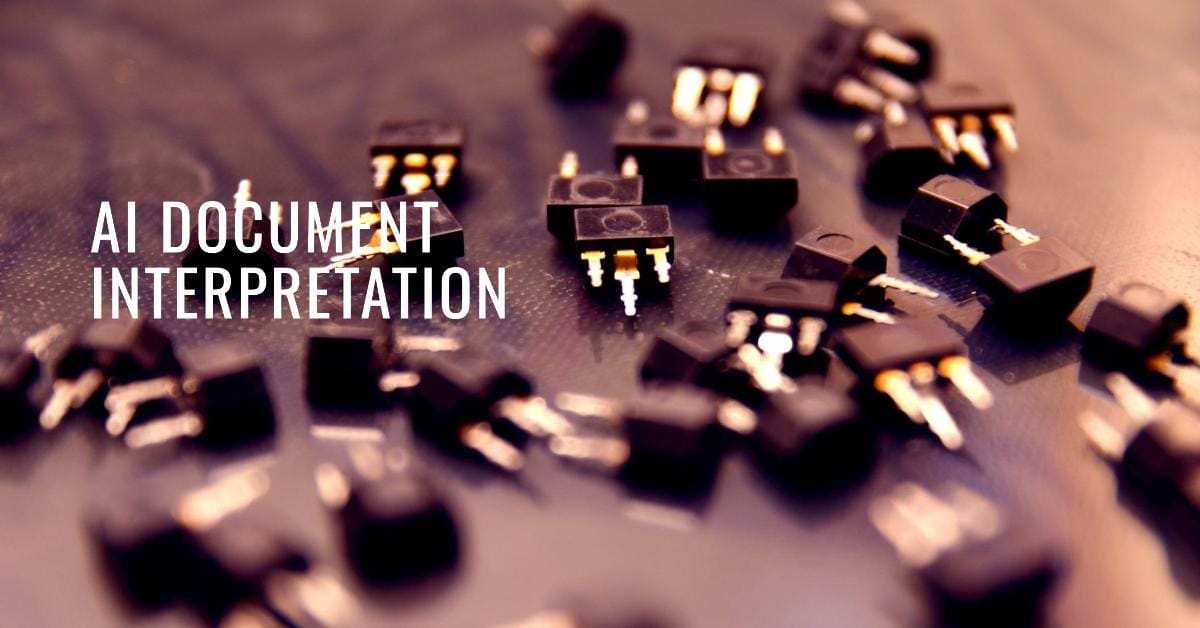How Accurate Is AI Document Interpretation?
How Accurate Is AI Document Interpretation? Ever wondered if AI can interpret documents as accurately as humans? You’re not alone! As more businesses adopt AI for tasks like document analysis and data extraction, the question of accuracy becomes increasingly important. In this article, I’ll walk you through what AI document interpretation is, how it works, and most importantly—how accurate it is. Whether you’re curious about implementing AI in your business or just fascinated by the technology, this guide will give you a clear understanding of its potential and limitations.
What Is AI Document Interpretation?
AI document interpretation refers to the ability of artificial intelligence systems to “read,” understand, and process information from documents. It uses a variety of techniques, including Optical Character Recognition (OCR), Natural Language Processing (NLP), and machine learning algorithms, to extract relevant data from texts, images, or forms. These technologies allow AI to interpret various types of documents, from invoices and contracts to handwritten notes and forms.
However, the real question isn’t just about what AI document interpretation is, but how accurate it is in practice.
How Does AI Document Interpretation Work?
To understand how accurate AI document interpretation is, it helps to first understand the underlying processes:
- Optical Character Recognition (OCR): This technology allows AI to “read” printed or handwritten characters in images or scanned documents and convert them into machine-readable text. OCR is particularly useful in digitizing physical documents.
- Natural Language Processing (NLP): NLP enables AI to understand and interpret human language. It processes written or spoken language, allowing the AI to comprehend context, intent, and meaning from documents.
- Data Extraction: After interpreting text, AI can extract relevant information—such as names, dates, or amounts—from the documents for further analysis.
While these processes are impressive, they aren’t flawless. Let’s take a look at how accurate AI can be and what factors affect its reliability.
Factors That Influence the Accuracy of AI Document Interpretation
The accuracy of AI document interpretation depends on several factors, which include:
- Quality of Training Data: AI models are only as good as the data they are trained on. The more diverse and accurate the training data, the more effective the AI is at interpreting documents. High-quality datasets that include various languages, document types, and writing styles ensure that the AI can adapt to different contexts.
- Complexity of Documents: Simple, structured documents like invoices or receipts are easier for AI to interpret accurately. On the other hand, unstructured documents—such as handwritten notes or poorly scanned images—can pose a challenge. In these cases, accuracy may drop, as the AI struggles to recognize text or interpret meaning.
- Type of AI Model Used: Different models have different capabilities. Advanced models, like GPT-4, are known for their exceptional accuracy in tasks like document interpretation, but older or simpler models may not perform as well.
How Accurate Is AI Document Interpretation?
The accuracy of AI document interpretation typically ranges between 85% and 95%. In optimal conditions—where high-quality images, clear text, and structured documents are involved—accuracy can even exceed 95%. For instance, state-of-the-art OCR systems can reach nearly 99% accuracy when interpreting printed documents.
However, it’s important to note that AI may not always achieve such high precision in more complex situations, such as:
- Handwritten Documents: Handwriting varies greatly from person to person, making it difficult for AI to interpret accurately. While some advanced OCR systems can handle handwritten text, the error rate tends to be higher—often ranging between 70% and 85%.
- Poorly Scanned or Damaged Documents: Low-quality scans, skewed images, or documents with stains and creases can significantly reduce AI’s accuracy. These imperfections make it hard for OCR systems to extract text correctly, and the accuracy may drop to around 60%-70%.
- Legal or Medical Documents: Legal and medical documents often use specialized language and terminology that may not be included in the AI’s training data, resulting in misinterpretation.
Examples of AI Document Interpretation
- Law Firms Using AI for Contract Review: Many law firms now rely on AI to review and analyze contracts. For simple contracts, the AI can interpret the text with an accuracy rate of over 90%, significantly speeding up the process. However, complex legal clauses may still require human review to ensure complete accuracy.
- AI in Healthcare: AI is being used to extract patient data from medical records, allowing healthcare providers to quickly access critical information. When trained on high-quality datasets, these AI systems achieve impressive accuracy, but when handling handwritten notes or older records, the accuracy may decrease.
- Financial Institutions Using AI for Data Extraction: Banks and other financial institutions often use AI to interpret documents like loan applications or customer forms. The structured nature of these documents helps AI achieve near-perfect accuracy in data extraction.
Best AI For Document Analysis?
When it comes to document analysis, choosing the best AI solution depends on the specific needs of your project—whether you’re looking for high accuracy in OCR (Optical Character Recognition), data extraction, natural language processing, or something more specialized. Here’s a list of some of the top AI tools for document analysis, each offering unique capabilities.
1. Google Cloud Document AI
Best for: General-purpose document analysis, OCR, and data extraction
Google Cloud’s Document AI offers powerful document parsing capabilities, using machine learning to extract structured data from documents. It supports invoices, receipts, contracts, and even medical documents, providing highly accurate OCR and natural language processing.
- Key Features: Pre-trained models for specific document types, multi-language support, and integration with Google Cloud services.
- Accuracy: High, with over 95% for structured documents.
- Use Case: Ideal for enterprises looking for scalable, multi-functional AI solutions.
2. Amazon Textract
Best for: Extracting data from complex documents like tables and forms
Amazon Textract automatically extracts text, forms, and tables from scanned documents. It’s particularly good at analyzing structured documents like invoices, receipts, or insurance claims.
- Key Features: Supports complex data extraction, integrates with AWS, and works well with PDFs and images.
- Accuracy: Around 90-95% for most structured documents.
- Use Case: Financial institutions, healthcare, and logistics.
3. Microsoft Azure Form Recognizer
Best for: Document understanding and information extraction
Azure Form Recognizer is a robust AI solution that specializes in recognizing and extracting text, key-value pairs, tables, and structures from documents. It also provides custom models that can be trained for more specific needs.
- Key Features: Custom model training, strong OCR capabilities, integrates well with other Azure services.
- Accuracy: Often exceeds 90% for custom-trained models.
- Use Case: Businesses that need customized document analysis solutions.
4. ABBYY FineReader
Best for: OCR and converting documents into editable formats
ABBYY FineReader is one of the most accurate OCR solutions available and is widely used in industries that require converting scanned documents and images into searchable, editable formats.
- Key Features: High-precision OCR, document comparison, multi-language support.
- Accuracy: 98-99% for printed documents.
- Use Case: Legal, healthcare, and education sectors that need high accuracy for document digitization.
5. Rossum
Best for: AI-powered data extraction for finance and accounting documents
Rossum is an AI-based data capture tool focused on extracting information from financial documents, such as invoices and purchase orders. It uses machine learning to improve its performance over time, making it a popular choice for automating document processing workflows.
- Key Features: Pre-trained models for finance, real-time data capture, and intuitive interface.
- Accuracy: Over 90% for financial documents.
- Use Case: Accounting, procurement, and finance departments.
6. OpenAI GPT-4 (Vision)
Best for: Complex document analysis and natural language understanding
GPT-4 Vision brings advanced capabilities to document interpretation, and handling tasks beyond basic OCR by offering deep natural language understanding. It’s particularly useful in contexts where both text extraction and interpretation are required, such as legal, research, or content summarization tasks.
- Key Features: Advanced text understanding, customizable outputs, and multi-tasking capabilities.
- Accuracy: 95%+ in structured document scenarios.
- Use Case: Research, legal document analysis, and multi-purpose NLP applications.
7. Kofax Capture
Best for: Enterprise-level document capture and processing
Kofax Capture provides AI-driven document capture and processing solutions that help companies automate workflows, including data extraction and classification from large volumes of documents.
- Key Features: AI-enhanced OCR, document classification, process automation.
- Accuracy: High, especially in enterprise environments with consistent document types.
- Use Case: Large enterprises looking to automate document-heavy processes like insurance claims or government applications.
Which AI Is Best for Your Needs?
- For General Document Analysis and OCR: Google Cloud Document AI and ABBYY FineReader are top choices, offering high accuracy and flexibility.
- For Financial Documents and Data Extraction: Amazon Textract and Rossum excel in extracting data from complex forms and tables.
- For Custom Model Training and Multi-Language Support: Microsoft Azure Form Recognizer provides excellent customization.
- For Natural Language Understanding: GPT-4 Vision is the best option for interpreting and analyzing complex text beyond just extraction.
Ultimately, the best AI for document analysis depends on your specific needs—whether you require high accuracy for a certain document type, scalability, or customizability.
Free AI document analysis
If you’re looking for free AI tools to perform document analysis, several reliable options offer robust features without cost. While free tools may have limitations in terms of usage caps, document types, or advanced functionalities, they can still handle tasks like OCR (Optical Character Recognition), data extraction, and text analysis. Here’s a list of some of the best free AI-powered document analysis tools:
1. Google Cloud Vision (Free Tier)
Best for: Free OCR and text extraction
Google Cloud Vision’s free tier allows users to extract text from images or scanned documents. You can process a limited number of pages per month for free, making it ideal for light usage.
- Key Features: OCR, image analysis, text recognition, multi-language support.
- Limitations: The free tier allows up to 1000 units per month.
- Use Case: Light OCR tasks, such as converting PDFs or scanned documents into editable text.
Google Cloud Vision
2. Microsoft Azure Form Recognizer (Free Tier)
Best for: Document form recognition and data extraction
Azure Form Recognizer offers a free tier that lets users analyze and extract text, key-value pairs, and tables from documents. It’s a good option for form-heavy documents like invoices or receipts.
- Key Features: OCR, form extraction, table recognition, structured data extraction.
- Limitations: 500 pages free per month.
- Use Case: Extracting structured data from forms or documents.
3. Tesseract OCR
Best for: Open-source OCR for text extraction
Tesseract OCR is an open-source OCR engine maintained by Google. It’s a powerful tool for extracting text from images and PDFs and can be easily integrated into various projects without any cost.
- Key Features: Free and open-source, multi-language support, customizable.
- Limitations: Requires technical knowledge to set up and optimize.
- Use Case: Developers or users with programming skills who need free OCR for large-scale projects.
4. Rossum (Free Tier)
Best for: AI-powered invoice and form data extraction
Rossum is a data extraction platform focused on documents like invoices and purchase orders. Its free tier allows you to upload documents and get structured data from them.
- Key Features: AI-based data extraction, form, and invoice processing.
- Limitations: Limited to 300 documents per month on the free plan.
- Use Case: Businesses or individuals needing free data extraction from financial documents.
Rossum
5. Amazon Textract (Free Tier)
Best for: OCR and complex form extraction
Amazon Textract offers a free tier where you can extract text, forms, and tables from scanned documents or PDFs. It’s useful for extracting both simple and complex document structures.
- Key Features: OCR, form and table extraction, supports complex documents.
- Limitations: 1000 pages of document text extraction per month.
- Use Case: Small businesses or individual projects with moderate document analysis needs.
6. PDF.ai
Best for: Simple, AI-driven PDF analysis
PDF.ai is a free tool for interacting with and analyzing PDF documents. It allows you to upload a PDF, ask questions, and extract meaningful insights from the content without any technical setup.
- Key Features: AI-powered PDF analysis, question-answering, and document insights.
- Limitations: Limited features compared to enterprise-level tools.
- Use Case: Quick, ad-hoc analysis of PDF documents.
7. Simple OCR
Best for: Basic, free OCR for image-to-text conversion
Simple OCR is a free, easy-to-use OCR tool for converting scanned documents and images into editable text. It’s suitable for basic text extraction tasks and works well for low-volume document processing.
- Key Features: Basic OCR, image-to-text conversion, simple interface.
- Limitations: Limited features compared to advanced tools.
- Use Case: Light OCR iis usedfor personal or small business projects.
Which Free AI Tool Is Best for You?
- For general OCR tasks: Google Cloud Vision or Tesseract OCR are great for free, accurate text extraction.
- For structured data extraction: Rossum and Amazon Textract offer good options for financial documents and forms.
- For document forms and tables: Azure Form Recognizer provides excellent form recognition for free.
- For simple PDF analysis: PDF.ai is a good choice if you need a quick, interactive way to get insights from PDF documents.
Each of these tools offers a powerful free tier for document analysis, and depending on your specific needs—whether it’s OCR, form processing, or data extraction—one of them should suit your project perfectly.
Challenges of AI Document Interpretation
While AI document interpretation offers impressive results, it’s not without its challenges:
- Contextual Understanding: AI may struggle to interpret the context in certain documents. For example, in a legal contract, the meaning of a clause can change depending on the specific context or legal terminology used.
- Bias in Training Data: If the data used to train the AI contains biases, the AI may misinterpret documents, especially if they come from underrepresented regions, cultures, or industries.
- Language Barriers: AI models trained primarily in one language may have difficulty accurately interpreting documents in another language, especially if the model lacks sufficient data in that language.
Improving AI Document Interpretation Accuracy
Despite these challenges, there are several ways to improve the accuracy of AI document interpretation:
- Improve Training Data: By providing more diverse and high-quality datasets, AI models can be trained to better recognize and interpret a wider variety of documents.
- Enhance Preprocessing Techniques: Preprocessing techniques, such as image enhancement and noise reduction, can improve the quality of scanned documents, leading to better OCR performance.
- Human-AI Collaboration: Combining AI with human oversight can ensure that AI’s errors are caught and corrected, especially in high-stakes environments like law and medicine.
FAQ – How Accurate Is AI Document Interpretation
1. What is AI document interpretation?
AI document interpretation refers to the use of artificial intelligence to read, extract, and analyze text or data from various types of documents. It involves technologies like Optical Character Recognition (OCR), Natural Language Processing (NLP), and machine learning models that can understand and process information from documents, images, PDFs, or handwritten notes.
2. How accurate is AI in interpreting documents?
The accuracy of AI document interpretation varies depending on several factors such as the quality of the AI model, the complexity of the document, and the training data. In many cases, top AI systems can reach up to 90-95% accuracy for text extraction and data interpretation, especially in structured documents like forms or invoices. However, accuracy can drop for more complex, unstructured documents or poorly scanned files.
3. What factors affect AI document interpretation accuracy?
Quality of the training data: The more diverse and high-quality the training data, the more accurate the AI will be.
Document clarity: High-resolution, well-scanned documents yield better results than blurry or poorly scanned ones.
Document complexity: Simple, structured documents (e.g., forms or tables) are easier to interpret than unstructured or handwritten ones.
Language and font: Unusual fonts, non-standard layouts, and multi-language documents can affect accuracy.
4. Are there limitations to AI document interpretation?
Yes, some limitations include:
Handwriting recognition: While AI has made strides in this area, interpreting cursive or poor handwriting remains challenging.
Unstructured documents: AI struggles more with free-form, unstructured text than with structured data.
Contextual understanding: AI may misinterpret or overlook nuanced meanings in the text without additional contextual information.
5. How does AI handle different languages?
Many AI document interpretation tools support multiple languages, but the accuracy often depends on the specific language and the model’s exposure to it during training. Languages with more complex grammar or script (e.g., Chinese or Arabic) may require specialized models for accurate interpretation.
6. What improvements can boost AI document interpretation accuracy?
Pre-processing documents: Enhancing document quality (e.g., improving scan resolution, and removing noise) can significantly improve AI performance.
Training with diverse datasets: Using more varied and representative training data increases AI’s ability to handle different document types.
Human-in-the-loop systems: Involving human oversight for corrections can help improve final accuracy in complex cases.
7. Is AI document interpretation reliable for legal or financial documents?
Yes, AI is increasingly used for interpreting legal, financial, and medical documents, especially where accuracy is critical. In these cases, AI systems are often paired with human reviewers to ensure the highest accuracy. Most AI tools for these industries report 90%+ accuracy rates when used with clear, structured documents.
8. How does AI compare to traditional OCR for document interpretation?
While traditional OCR is limited to basic text extraction, AI document interpretation goes beyond that by understanding context, extracting meaning, and even interpreting tables, forms, or handwriting. AI-powered OCR can adapt to various document types and provide more accurate and insightful interpretations.
9. What are some examples of free AI tools for document interpretation?
Google Cloud Vision and Amazon Textract offer free tiers for OCR and document analysis.
Tesseract OCR is an open-source tool useful for basic text extraction.
Rossum and Azure Form Recognizer provide free plans for structured document interpretation like invoices.
10. Can AI document interpretation replace human data entry?
AI can greatly reduce the need for manual data entry, particularly for high-volume or repetitive tasks. While it may not fully replace human effort in complex cases requiring contextual understanding, AI can significantly speed up and automate much of the document processing work, improving productivity.
11. What industries benefit the most from AI document interpretation?
Industries like finance, healthcare, legal, and logistics heavily benefit from AI document interpretation. It streamlines processes like invoice processing, legal contract review, medical record analysis, and even shipping and logistics management by automating document-heavy tasks.
Conclusion: Is AI Document Interpretation Accurate Enough?
To answer the question directly: AI document interpretation is highly accurate, typically ranging from 85% to 95% depending on the conditions. In scenarios where high-quality data and structured documents are used, AI can exceed 95% accuracy. However, the accuracy drops in more challenging environments like handwritten or poorly scanned documents.
While AI document interpretation has made incredible strides, it still requires human supervision in certain situations to ensure total accuracy. For routine tasks, however, AI can be a game-changer, saving both time and resources while delivering results with remarkable precision.





